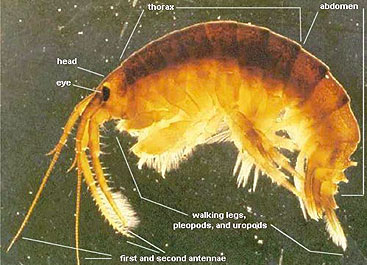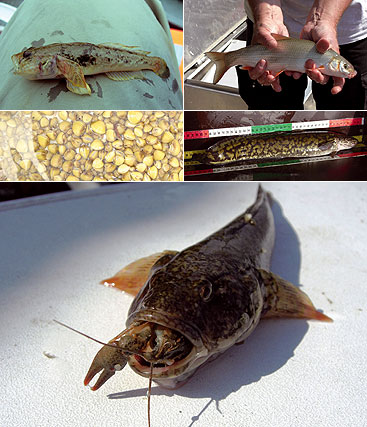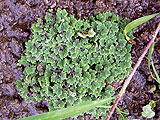Invasion of the Danube
ICPDR Danube Watch: Searching for heavy metals behind the Iron Gates

Invasion of the Danube
Results of the Joint Danube Survey 2 reveal that invasive species have become a major concern for the Danube, and that their further classification and analysis is vital for effective river basin management. The question of how to deal with them is the subject of constant discussion among EU member states.

Called ‘killer shrimp’ or the ‘pink peril’, Dikerogammarus villosus is a voracious predator that can colonise a wide variety of substrates, adapt to a wide range of habitats and survive fluctuations in temperature, salinity and oxygen levels.
The JDS2 found that killer shrimp, asian clams and carpets of weeds have invaded the danube River basin. More now needs to be done to understand why they arrived, what impacts they are having and what to do about them – if anything at all.
Dikerogammarus villosus is a voracious predator. Also called ‘killer shrimp’, the ‘pink peril’ and ‘freshwater jaws’, the small macroinvertebrate – an aquatic insect, crustacean, worm, clam, snail or other animal without a backbone that can be seen without the aid of a microscope and that live in or on sediments – kills by biting and shredding prey, tending to be much deadlier than its competition because of its powerful mouthparts. They can colonise a wide variety of substrates, adapt to a wide range of habitats and survive fluctuations in temperature, salinity and oxygen levels. Some people have seen them attack small fish. And they can cause significant ecological disruption such as reducing species.
On top of it all, they are not even from the Danube River Basin. Killer shrimp originate from the Ponto-Caspian area, meaning the Black, Azov and Caspian Sea regions, and are therefore known as invasive – nonnative species that adversely affect the habitats they invade either economically or ecologically.
During the Joint Danube Survey 2 (JDS2) in 2007, probably the world’s biggest river research expedition ever, killer shrimp were found to be the third most frequent invasive macroinvertebrate species found along the Danube, observed at 69% of all sampled sites.
Asian clams, or Corbicula fluminea, were the most frequent invasive macroinvertebrate species found, observed at 93% of the sites sampled along the Danube River. Asian clams don’t bite. They don’t even swim fast. But they are still highly invasive. This species can release up to 2000 one-millimetre-long juveniles per day and more than 100,000 in a lifetime. Adults can become as long as 5 cm. That’s a lot of clam.
The silver medal for most frequent invasive macroinvertebrate species goes to the Caspian mud shrimp Corophium curvispinum, observed at 90% of sites sampled.

Native species like the nase (upper right) must compete with invasive species such as goby (upper left and bottom) and Asian clams (centre left). Only one native species, burbot (Lota lota), benefits from newcomers, and feasts on the increasing pools of small goby which grow only to 7 cm.
With few exceptions, invasive macroinvertebrate species
belong to the Crustacea and Mollusca groups and
were found by the JDS2 to be distributed along the
entire Danube stretch. Other notable aliens included
the Northern river crangonyctid (Crangonyx pseudogracilis),
a neozoon – an animal species that reached,
after the year 982 AD (first introduction of American
organisms in Europe; trans-Atlantic cruise of Eric the
Red), under direct or indirect anthropogenic involvement,
a specific area and has lived there wildly for at
least three generations or over a longer period (at least
25 years) up to now (neo = new, zoon = animal; plural:
neozoa) – originating from North America, possibly via
the timber trade, found for the first time in the entire
Danube. And Corophium robustum (see Rhine box) was
documented for the first time in Austria.
Overall, the JDS2 found that invasives have become a major concern for the Danube, and that their further classification and analysis is vital for effective river basin management. The question of how to consider them is the subject of constant discussion among EU member states.
The JDS2 found that many invasive species reach tremendous abundance (the number of individuals per species) in specific river stretches in the basin. In the Middle Reach of the Danube, they made up an incredible 100% of all species abundance at some sites. In the Upper Reach, invasives accounted for up to 90% of specimens observed at some sites. They further accounted for approximately 40% of all of the documented species aggregated together in the Upper and Middle reaches. For example, Asian clams were often one of the only species found at many sites, given their ability to survive current and bottom conditions there. In effect, their increasing presence needs to be taken seriously – especially in places where they are so dominant, their continued existence there may be preferable.
INvasIvEs aNd ThE RhINE
According to a 2006 article in Aquatic Invasions*, the authors found that the macroinvertebrate richness of the Rhine River was substantially reduced over the last century due to human impacts. By the early 1970s, only one-quarter of the more than 160 species identified prior to 1920 could still be found.
Over the last 30 years, water quality improved and macroinvertebrate species richness largely recovered. However, community composition has been severely altered by invasive species. The opening of the Main–Danube Canal in 1992, linking the Rhine to the Black Sea, was a key cause.
Within a year, the first macroinvertebrate species of Ponto-Caspian origin were documented. In 2003 and 2004, a number of samples were taken along a section of the Rhine. The study found that nine alien species contributed 74.7% and 72.1%, respectively, to the total number of invertebrates collected. A total of 33 alien macroinvertebrate species were identified in the study, including the first record of Corophium robustum from the Rhine. Corophium robustum, a shrimp-like species of Ponto-Caspian origin, most likely entered the Rhine Basin facilitated by ship traffic through the Main–Danube Canal.
Overall, the study found that the macroinvertebrate community of the upper Rhine River has been severely altered by the invasion of several highly successful neozoa and the disappearance or population decline of native species. Besides this displacement of native by alien species, there has also been a rapid succession in the numerical dominance of ‘old’ neozoa (mainly from North America) and ‘new’ Ponto-Caspian neozoa.
Hello rip-rap, goodbye natives. Incredibly, the Danube probably remains the European river with the greatest fish diversity. In total, the JDS2 sampled over 64,000 fish consisting of 71 separate species – 66 species in the Danube and 58 in the tributaries.
At the same time, several native species are disappearing. One key cause is the loss of natural habitats, especially in the Danube’s Upper Reach where hydromorphological alterations (changes to the physical characteristics of the shape, boundaries and content of the river) are the main negative pressure, as opposed to poor water quality. Here, and along the Middle Reach, many significant changes have been carried out to enforce the river’s banks, creating artificial `rip-rap´ habitat – basically large boulders that have been artifi-cially placed, especially at channelised and impounded river sections.
“Such habitat has now become ideal for a high abundance of Neogobius (or goby) species in parts of the Upper Danube – species which have not been historically present in the Upper Reach before,” says JDS2 Fish Team Leader Christian Wiesner. “Several goby species (Neogobius spp.), immigrants from the Black Sea, were found in high or even dominating abundances along the rip-rap protected and regulated banks. In contrast, downstream of the Iron Gate in the gobies’ native range (rkm 850-0), where hydromorphological impacts on the river are much lower, goby abundance is low and only slowly increases towards the Danube Delta.”
Only one native species, burbot (Lota lota), benefits from the bounty of food in the vast stretches of arti-ficial rip-rap habitat. For example, burbot, which can grow up to 1 m in length, feast on the increasing pools of small goby which grow only to 7 cm. Non-native eels (Anguilla anguilla) also benefit from the high extent of rip-rap. Observed by the JDS2 only in the very Upper reaches, juvenile eels are stocked mainly in the German part of the basin and soon vanished from JDS2 catches in the Austrian section.
Overall, the diversity of Danube fish fauna has become significantly reduced and clearly dominated by eurytopic species – those which do not have special demands or requirements concerning their environment. These include roach (Rutilus rutilus), Prussian carp (Carassius gibelio), white bream (Blicca bjoerkna) and bleak (Alburnus alburnus) which were historically only important in the Lower Reach of the Danube. By definition, species such as Prussian carp are not ‘invasive’, but they are spreading and multiplying in new areas.
Water weeds. During the JDS2, the presence of water hyacinth (Eichhornia crassipes), most likely resulting from human impacts, was observed. Considered one of the worst aquatic weeds in the world, it is a fast growing plant with populations known to double in as little as 12 days. Infestations of the weed block waterways, limit boat traffic, swimming and fishing, and prevent sunlight and oxygen from penetrating the water surface. Shading and crowding of native aquatic plants can dramatically reduce biological diversity in aquatic ecosystems. “Its properties and competitive power may be a considerable threat to oxbow and still water systems in the Danube floodplains if further warming continues. Mediterranean countries already suffer from this weed,” says the University of Vienna’s Professor Georg Janauer, responsible for JDS2 macrophyte (plant) assessments.

The water fern Azolla filiculoides is a floating plant originating from North and South America. The beautiful plant can invade a region rapidly, form dense mats, outcompete native plants and animals and also causes problems in drainage and water systems.
The water fern Azolla filiculoides is a floating plant originating from North and South America. While observed only in low numbers during the JDS2, the beautiful plant can invade a region rapidly, form dense mats, out-compete native plants and animals and also causes problems in drainage and water systems. Dense infestations, which completely cover the water surface, are a danger to children, pets and livestock who may attempt to walk onto the apparently dry land without appreciating that there is deep water underneath. The dense cover of floating weeds also reduces the light level beneath the surface so that submerged weeds and algae die off causing serious deoxygenation problems. Free-floating weeds can also be drawn into water intakes, blocking pumps and filters, and can cause flow problems and obstructions to weirs, locks and other structures.
Why are the natives losing? The Danube River Basin is extremely vulnerable to invasive species given its direct linkages with other large water bodies. Many invasives originate from the Ponto-Caspian area, Asia, Australia and North America. The Danube is a part of the Southern Invasive Corridor (Black Sea–Danube-Main/Danube Canal–Main–Rhine–North Sea waterway), one of Europe’s four most important routes for invasive species. The river is therefore exposed to intensive colonisation of invasive species and further spreading in both north-west and south-east directions throughout the basin.

The unexpected spread of duckweed (an important food source for waterfowl) was observed in the main river channel. Duckweed is any of various small, free-floating, aquatic flowering plants of the genus Lemna, growing in close, often carpet-like colonies on the surface of quiet water. These simple plants, lacking a stem or leaves, but consisting of a small blade-like structure floating on or just under the water surface, grow rapidly and absorb excess mineral nutrients, particularly nitrogen and phosphates.
“There are several opinions on this topic,” says Wolfram Graf, an Austrian biologist and upper Danube expert for the JDS2. “My personal view is that pollution and habitat degradation have weakened the indigenous faunal elements allowing neozoa to take over. In many cases, they prefer man-made structures like rip-rap where they settle and spread. Climate change may be one fact, but this is not verified. We are currently working on this topic.”
The climate is of course getting warmer, and this is having an effect on the Danube and its species. Rising water temperatures lead to lower dissolved oxygen concentrations in the water, with implications for the survival of native species – especially if they cannot move their home ranges due to migration barriers such as dams.
“Climate change may therefore cause further declines for native species, thereby decreasing the competition for non-natives and enabling their increased establishment,” says Wiesner. “However, there is no conclusive data yet on the subject of invasive fish species and its link with climate change in the Danube.”
Interestingly, the existence of many alien plant species found during the JDS2 might be attributable to climate change. For example, Azolla filiculoides is rarely found in temperate climates, indicating that its migration up the Danube may be a result of climate change. The unexpected spread of duckweed was probably triggered by the warm winter period. And the presence of eared watermoss (Salvinia natans), a plant species requiring warm conditions, near Vienna could be an indication of climate change-induced migration up the Danube.
But a crucial question to be asked here is: Is the Danube really losing out because of invasives?
“Danube flora and fauna forever change, as they do in any large river system, largely because of human impacts,” says JDS2 Team Leader and biologist Béla Csányi. “Many species that are being called “invasives” here should not be seen as problems. Many are beautiful, and some, like Asian clams, prove that some Danube sites with difficult conditions can still support life. If certain species that used to be either non-existent or in low numbers now happen to be undergoing mass production, then it’s not their fault – it’s ours.”





